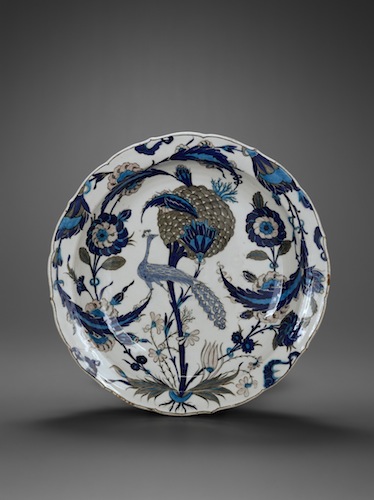Ceramics - Peacock Dish
Origin and time: Turkey, 1550
Louvre, Paris
This fine plate represents a masterpiece of Ottoman ceramics. A complex vegetal composition covers the whole surface. The colours chosen for the decoration demonstrate vegetal richness; numerous overlaps and features of vegetal forms create a three-dimensional effect. The decoration combines the palette of subtle colours, a harmony of blue, turquoise, and pink monochromes with the dark green colour of the outlines. These colours take the viewer back to the days this object was produced. Most of the vegetal motifs, and the palette of hues, could be seen on other Ottoman ceramic wares from the 1540s and 1550s.
The centre of the dish features an errant peacock, lost in a fantastic garden. The vegetal composition around it consists of long serrated leaves, imaginary or composite flowers, characteristic elements of the saz repertoire of ornamentation in Ottoman art. Saz in old Turkish refers to a dense forest, where animals and mythical creatures live. The vegetal composition on the dish makes the viewer remember the artistic spell saz: such ornamentation with graphical illustration facilities was used in ottoman art for all kinds of backgrounds. The decoration is exceptional in all respects; the choice of the peacock is of great significance, as symbol of beauty, royalty and power having spread to the Ottoman court from Persian.
